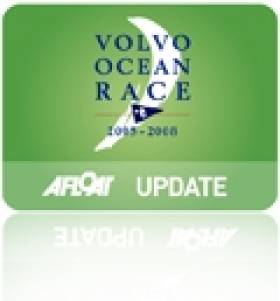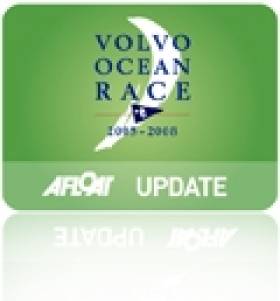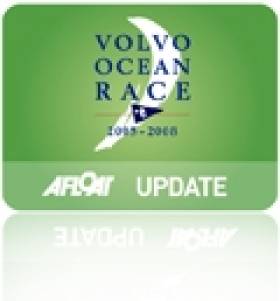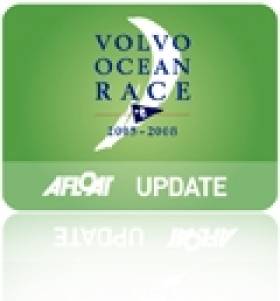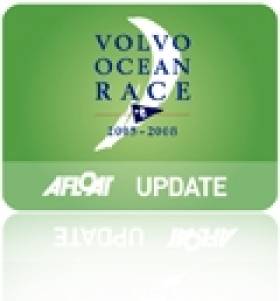Displaying items by tag: Team Alvimedica
#VOR - Team Alvimedica made a triumphant entry into The Hague at 1.34am local time this morning (Friday 19 June) and put themselves in pole position to win Leg 9 of the Volvo Ocean Race.
The Turkish/American team, skippered by Charlie Enright (USA), still have 480 nautical miles of the final leg of the nine-month offshore marathon to negotiate to Gothenburg, Sweden, having sailed two days, eight hours and 34 minutes since leaving Lorient in France on Tuesday.
That gave them a 26nm advantage over the second-placed boat Dongfeng Race Team (Charles Caudrelier/FRA), which finished at the Dutch port more than 1hr 45mins behind.
“It always feels good going into the locker room at halftime ahead, but that’s all it really is," said Charlie Enright shortly after crossing the line. "It’s kind of like Cape Horn, no points but still a great accomplishment.”
Enright, 30, the youngest skipper by far in the race, also led his team to the Cape Horn landmark ahead of the fleet on Leg 5, but relinquished that lead and eventually finished third.
If Team Alvimedica can complete the job and win in Gothenburg, they would be the sixth of seven boats in the competition to have won a leg in this 12th edition.
They have already shown their top form, winning the SCA In-Port Race Lorient at the weekend, for their second success of the in-port series.
“It sounds like there’s a fight [behind us]. It’s nice to be watching it and over the line,” he added.
Enright talked through the ‘decision of the leg’ – whether to hug the English coastline or stick, as he did, to the French and Dutch shorelines to the south of the English Channel.
Initially on Thursday it looked as if north would pay, as Dongfeng Race Team, MAPFRE (Iker Martínez/ESP) and Team Brunel (Bouwe Bekking/NED) seemed to be making gains in stronger winds midway through the day.
But Team Alvimedica stuck to their guns and eventually the tides and breezes turned to their advantage for an entrance into The Hague and across the finish line, chased by dozens of spectator boats.
They will head out of The Hague at 12 noon local time on Saturday 20 June with their 1hr 46min 29sec advantage over Dongfeng Race Team, and the rest of the fleet also taking their advantages and deficits over their rivals, in a staggered start.
The seven boats are due to finish the leg in Gothenburg on the afternoon of Monday 22 June, according to the latest estimates.
If Team Alvimedica were to be first into port there too, they would need Team Vestas Wind (Chris Nicholson/AUS) and Team SCA (Sam Davies/GBR) to improve on their current sixth and seventh places and sandwich themselves between Enright’s crew, Dongfeng Race Team and MAPFRE, to take an overall podium place.
Team Brunel were hoping to do better than fourth place sailing into their home port, but as Bekking said before the leg started, only the finishing positions in Gothenburg really matter.
Meanwhile, Abu Dhabi Ocean Racing (Ian Walker/GBR) sailed serenely on to claim fifth place in The Hague, having avoided any major problems on the first half of Leg 9.
They have an unassailable eight-point advantage over Team Brunel at the top of the overall standings.
If the current positions stay as they are, Abu Dhabi Ocean Racing would have 24 points, Team Brunel and Dongfeng Race Team 31 apiece, MAPFRE and Team Alvimedica 34 each, Team SCA 51 and Team Vestas Wind 60.
That would leave the Inmarsat In-Port Race Gothenburg on Saturday 27 June to split the ties between second and third and fourth and fifth: the perfect finale to one of the most closely contested races in 41 years of event history.
#VOR - Team Alvimedica claimed their second Volvo Ocean Race in-port race series victory in Lorient, France today (14 June) after leaving their rivals trailing following a delayed start due to lack of wind.
The victory, which follows their triumph in the opening in-port race in Alicante eight months ago, bolsters the hopes of Charlie Enright’s crew to claim a much-coveted final podium finish in the series that concludes in Gothenburg, Sweden on 27 June.
The SCA In-Port Race Lorient victory will also lift their chances of a top-three finish in the overall standings.
The series acts as a tie-breaker for the tightly contested second and third places in the offshore competition that also finishes in Gothenburg the week after next.
A lack of breeze on the race track kept the fans in Lorient waiting some 30 minutes before the action started, but there was drama aplenty from the off.
MAPFRE (Iker Martínez/ESP) were forced to duck behind the rest of the seven-strong fleet as a premature start loomed and they immediately conceded seemingly costly ground on their rivals in such a key race.
Team Alvimedica had no such problems and led the boats on the windier right hand side of the course, giving them a good advantage in the chase to the first gate.
Team SCA (Sam Davies/GBR) and Team Vestas Wind (Chris Nicholson/AUS), first and second respectively in Leg 8 from Lisbon to Lorient, chose the lefthand side of the course and that stored up problems for them as they approached the first mark.
Both were ordered to take penalty turns: the all-women crew for apparently failing to give MAPFRE enough space (or rather, water) as they tacked around the mark, and Team Vestas Wind for committing a similar offence against Team Brunel (Bouwe Bekking/NED).
The fleet split right and left on the next leg, while Team Alvimedica cruised untroubled away at the head of the fleet, building their lead to around 300 metres.
By the fourth leg, the young Turkish/American-backed crew continued to stretch away with Abu Dhabi Ocean Racing heading the chasing pack and quite happy to consolidate their position at the top of the overall in-port race standings if they could.
The result now was in no doubt in terms of who would win, but Abu Dhabi Ocean Racing, Team Brunel and Dongfeng Race Team were still separated by only metres as the fifth leg continued.
As the leg finished, Azzam and no less than three other boats converged on the mark with Team Brunel, MAPFRE and Dongfeng Race Team scrapping for second place with the Emirati boat.
Into the final leg, MAPFRE steamed through in the closing stages with a perfect angle and extra wind to snatch second from Walker’s crew and Dongfeng Race Team also bypassed the Emirati boat as the line approached, leaving them fourth.
Team SCA then won a three-way showdown for fifth, just ahead of Team Brunel, with Team Vestas Wind taking seventh.
The results leave the in-port standings perfectly poised for the final deciding race in Gothenburg.
Abu Dhabi Ocean Racing, the overall event winners elect, are still top on 25 points, six clear of Team Brunel (31), with Team Alvimedica (32), Team SCA (33), MAPFRE (34) and Dongfeng Race Team (36) all with good chances of podium places.
Team Vestas Wind, who missed all the in-port races from Abu Dhabi to Newport, Rhode Island because of their rebuild following a collision with a reef, are on 66 points.
Should Team Brunel win the final race in Gothenburg, they would lift the trophy at the expense of Abu Dhabi Ocean Racing since they would have the most individual victories in the series.
Walker, who is already assured of the main offshore trophy as long as his crew do not pick up a batch of penalty points in the final leg from Lorient to Gothenburg, was satisfied with Sunday’s performance.
“It was a good result for us,” he told reporters. “We were just trying to cover Team Brunel and to get enough points to get the series won. We’ve not quite done that, but we’re in a pretty good position.”
Enright then summed up: “We had a really, really good start which made it pretty easy to execute our game plan. We need another good result in Gothenburg to close the deal.”
Team Alvimedica Get Redress For Time Lost Assisting Vestas Crew
#VOR - Team Alvimedica have won a claim for redress over time lost while diverting to assist the stricken Team Vestas Wind during the second leg of the 2014-15 Volvo Ocean Race, according to the official race website.
As previously reported on Afloat.ie, the American-led team altered course to assist their race opponents after the Team Vestas yacht grounded on shoals in the Indian Ocean between Madagascar and Mauritius on 29 November.
The Alvimedica crew stood on standby till they were cleared to continue racing north when it was determined the Vestas team were in no immediate danger.
They eventually came in fifth of out of the six finishers when they arrived in Abu Dhabi on 14 December.
However, an independent jury hearing held by the ISAF has ruled that Team Alvimedica were cost a race position, both by the time they lost stopping to assist their fellow competitors and by missing out on the remnants of a tropical storm that boosted their rivals on approach to the UAE.
The team received an extra point, bringing their total to four, without affecting the finishing positions of the rest of the fleet.
“It’s nice to have the point but it’s a small step in a big journey," said Team Alvimedica skipper Charlie Enright. "It doesn’t change the overall standings currently, it doesn’t affect the positions of the other boats in the last leg, but later a point could be fairly big."
The VOR website has more on the story HERE.
Volvo Ocean Race Is A 'Test Of Sanity'
#VOR - Wired gets on board with Team Alvimedica to peruse the state-of-the-art Volvo 65 as training progresses ahead of the next Volvo Ocean Race later this year.
Already described as 'a tougher beast all round' by those in the know, Wired's Tim Moynihan takes a look at the new one-design racing yacht from a logistical as well as a tech and design perspective.
The article comments on the immense planning involved in keeping eight people fit and sane in such cramped conditions, not to mention keeping them well fed as they race around the world.
"Too much food will add unwanted weight to the boat," writes Moynihan. "Too little of it would be disastrous during a slower-than-expected leg. During the last Volvo Ocean Race, the American PUMA Ocean Racing team ran out of food a day and a half from port on one leg."
The boats this time round will also be mini broadcasting powerhouses, each equipped with five cameras linked to a computer-driven media centre for swift editing of video packages.
Wired has much more on the story HERE.
American-Led Team Latest To Launch Volvo Ocean Race Bid
#VOR - Scuttlebutt Sailing News reports on the American-led Team Alvimedica, the latest - and youngest - team to hit the water running in their preparations for this year's Volvo Ocean Race start.
Spearheaded by young guns Mark Towill and Charlie Enright - Brown University alumni who first met on the set of a Disney sailing movie seven years ago - the team is essentially a metamorphosis of the company sailing squad formed two years ago by the title sponsor, a Turkish medical device firm.
Team Alvimedica launched its yacht out of Green Marine in Southampton earlier this week, and is now actively recruiting sailors to join its crew with six months to go till the first in-port race in Alicante.
Towill and Enright join Dutch prospects Team Brunel, China's Dongfeng Race Team, the all-women Team SCA and the returning Abu Dhabi Ocean Racing - featuring Irishman and past race winner Justin Slattery among its crew - in the line-up for the 2014/15 round-the-word yachting challenge.
Scuttlebutt Sailing News has more on the story HERE.


























